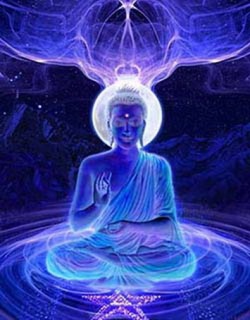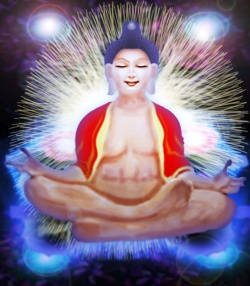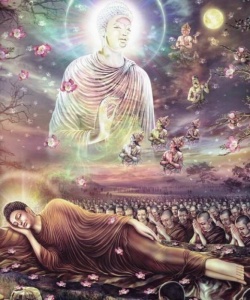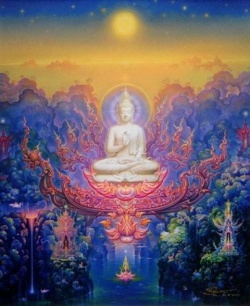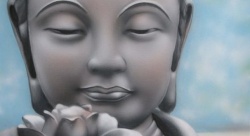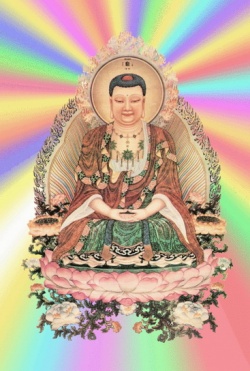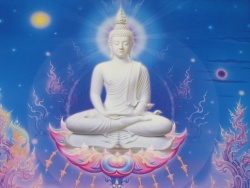Difference between revisions of "Studies in Buddhadharma - On Nirvâna"
m (Text replacement - "change" to "change") |
m (1 revision: Robo text replace 30 sept) |
(No difference)
| |
Revision as of 17:37, 30 September 2013
| "This is peace, this is exquisite : the resolution of all fabrications, the relinquishment of all acquisitions, the ending of craving ; dispassion ; cessation ; nirvâna."
|
"... nirvâna, the unexcelled safety from bondage !"
| |||||
| "The destruction of desire, the destruction of hatred, the destruction of ignorance : this, friend, is called 'Nirvâna'".
|
"Nirvâna is the foremost ease."
|
"Nirvâna" is the ultimate goal or fruit of the paths proposed by all Vehicles of the Buddhadharma.
In short, "nirvâna" implies the irreversible cessation of suffering. Conceptually, an exclusive negation pertains (strict apophatism). Experientially however, affirmative, katapathic contents are given, namely the enlightened body, enlightened speech, enlightened mind & enlightened action of a Buddha.
Distinguished Western scholars say "nirvâna" means "to blow out". They base this on the Sanskrit "nir" as "out" + "vâna" as coming from "vâ", meaning "to blow". The word would suggest the act of extinguishing, extinction or unbinding. This is the image of blowing out the flame of a butter lamp. Here the action ending the fire comes from without, implying the agent is separate from the flame.
Another view is possible. In this, the flame is not blown out (as if one could cause an absolute state !). The end of the flame comes from within, i.e. is part of the conditions causing the fire.
In general, as an outer offering to the Buddha, a fire-offering should, once lit, never be disturbed, but venerated. To blow it out would be disrespectful towards the ideal proposed by the Buddha. Even in Vedic fire rituals this respect for the continuity of the presence of the flame was pertinent. It prevailed in Ancient Egypt (cf. the lamp of the Morning Ritual left in the "holy of holies" to burn to its end), and is found in the everburning light near the Holy Host in Roman churches. As one enters a clearing in the forest, moving into open space, likewise the flame, as it were exhausted, vanishes because there is no wood to fuel the fire. The particle "ni" negates "vâna", meaning "weaving, sewing", closing up space with an intricate network of causal threads (dependent-arisings of suffering). This is negated : the causes of suffering are eliminated. Dependent-arisings of bliss remain.
Without ignorance, one no longer weaves one's own misery !
The fire (of ignorant craving) is extinguished because at some point the fuel is consumed and so no longer available. There is no ground (or cause) for the fire to be there again, and so it vanishes from sight. This end or cessation of the fire does not cause "nirvâna", as it would in the conventional, functional process, but dispells the hinderances in the face of ultimate truth. "Nirvâna" is supramundane, beyond anything worldly. Therefore non-conceptual & object of nondual prehension.
The "fire" thus gone is not annihilated in the ontological sense. This would be like saying "nirvâna" does not exist, which is not the case. The flame has, by passing into space ("âkâśa"), just become invisible to ordinary sight, entering into a supramundane mode about which nothing can be said. Neither does "nirvâna" exist as an eternalized object "out there" (like a Creator-God like Brahman) or does it exist somewhere "in here" (like an eternal soul or "âtman") ...
Tibetan scholars take the Sanskrit "vâ" in "nirvâna" from the root "vrit", or "to pass beyond". So in Tibetan, "nirvâna" comes as "passed beyond sorrow" (Tib. "mya ngan las 'das pa"), i.e. the cessation of suffering. This is an excellent synthesis of both apophatic & katapathic meanings. "Nirvâna" is not some thing, neither is it nothing.
"Nirvâna" is the goal or fruit of the Buddhayâna and should not be confused with annihilation (the fruit is non-existent) or eternalization (the fruit exists for ever from its own side). Being always there (aware of the continuous present), it neither comes about from previous causes, nor does it spring into existence as a result of an act of creation. It was never created, always was, is and will be. But due to the mental & emotional darkness of ordinary benighted sentient beings, it remains unconscious, temporarily hidden (just as clouds shield the Sun).
What Nirvâna is Not
These so-called "formless" absorptions are the kind of mystical experiences happening before entry into "nirvâna". They are mundane (part of "samsâra"), while "nirvâna" is supramundane (escaping "samsâra"). The mind distinguishing both is samsaric ! Nevertheless, the Form Realm of the gods does provide entry into "nirvâna", albeit very difficult to attain.
By themselves, these and other mystical experiences differ from "nirvâna". "Nirvâna" does not cease and so once achieved, can never be lost ! This is a distinct difference from the "samâdhi" (union) associated with the "dhyânas" or "jhânas" of the Form & Formless Absorptions, with their arising, abiding & ceasing. Even in Hindu yoga, this distinction is acknowledged (cf. the difference between seedless union and "dharma-megha-samâdhi" or "Dharma Cloud Union" in the Yoga-Sûtra of Patañjali).
In one of the manuscripts of the Christian mystic John of the Cross (1542 - 1591), historians found a remarkable & outstanding didactical poem. It is a tribute to undifferentiated cognition, known in Royal Yoga as "nirvikalpa-samâdhi", or non-conceptual union. Read how John returns from this loftly level to normal consciousness.
John of the Cross wrote :
"I entered not knowing where.
And I remained not knowing.
Beyond all science knowing.
I did not know where I entered,
But when I saw myself there,
Not knowing where I entered,
Many things I suddenly learned ;
I will not say what these things were,
For I remained not knowing,
Beyond all science knowing.
It was peace, it was love,
It was the perfect knowledge,
In deep loneliness
I saw with wisdom ;
It was a thing so secret
I was left babbling and trembling,
Beyond all science knowing.
I was so far beyond,
So lost and absorbed,
I lost all my senses
I was of all sensing dispossessed ;
And my spirit was filled
With knowledge not knowing,
Beyond all science knowing.
Whoever truly reaches there,
To himself he is lost ;
All he knew before
Now appears very base ;
But his knowledge grows,
And he remains not knowing
Beyond all science knowing ...
This knowing by not knowing,
Is of such high power,
That the arguments of the wise
Are unable to grasp it ;
For their knowledge does not explain
Not to know knowing,
Beyond all science knowing.
And this exalted wisdom
Is of such excellence,
That no faculty of science
Can hope to reach it ;
But he who learns to conquer himself
With this knowledge of not knowing,
Will always go beyond all science knowing."
John of the Cross : I Entered not Knowing Where, before 1584.
In the second verse of the Samâdhi-pâda, the first book of the Yoga-sûtra, the theist, non-Buddhist yogi Patañjali (ca. 3th century CE) also defines enlightenment as restriction, the cessation of fluctuations caused by the five causes of sorrow :
- "Yoga is the restriction of the fluctuations of consciousness."
- Patañjali : Yoga-sûtra, I.1.2.
As long as fluctuations exist, enlightenment is veiled by the yogi's identification with the flux. Eliminate this by restriction ("nirodha"), and "samâdhi" occurs. For Patañjali, ultimate union ("dharma-megha-samâdhi") happens only after death, while during life, the liberated yogi or "jîvanmukta" cannot settle in "seedless samâdhi" permanently. For sure, an instance of such intense union transforms the mind radically, but subtle & very subtle obscurations remain. So he is like the one who sees how the wheel of the potter still turns after adding no more motion to it.
The difference with the Buddhadharma is pertinent : the Hindu yogi comes out of "seedless union" and may "settle" in cosmic consciousness, meditating on "Iśvara", the "Lord of the Universe", a yogic form of Brahman (Patañjali warns against focusing on becoming). This state is not "nirvâna", but a worldly (immanent) "devalike" ("godlike") consciousness. While possessing humongous stores of merit & extreme power, such Divine states are impermanent, and invite a steep "fall" doomed to be highly unpleasant. They lack wisdom, the realization of the universal process-like nature of phenomena.
Description of Nirvâna
The outstanding marks of "nirvâna" are absence of arising, subsisting, changing and passing away, or the negation of "samsâra". In the canons, we read how Buddha describes it as : "infinite" ("ananta"), "non-conditioned" ("asamkhata"), "incomparable" ("anupameya"), "supreme" ("anuttara"), "highest" ("para"), "beyond" ("pâra"), "safety" ("tâna"), "highest refuge" ("parâyana"), "security" ("khema"), "happiness" ("siva"), "unique" ("kevala"), "abodeless" ("anâlaya"), "imperishable" ("akkhara"), "absolute purity" ("visuddho"), "supramundane" ("lokuttara"), "immortality" ("amata"), "emancipation" ("mutti"), "peace" ("santi"), etc. So affirmations can be made !
But despite these descriptions, no predication of the word "nirvâna" can ever be literally true, for conceptual thought cannot process nondual, intuitive cognition or direct insight (wisdom). Other traditions confirm this. Both the Western "via negativa", with its apophatic theology of God, and the Hindu "neti, neti" approach of Brahman (cf. Brihadâranyaka-Upaniśad), clarify how true conceptual approximation of absolute truth and the depth of reality, only leaves one with negations :
"Unrelinquished, unattained,
Unannihilated, not permanent,
unarisen, unceased :
this is how nirvâna is described."
Nâgârjuna, Mûlamadhyamakakârikâ, XXV.3
The core of Buddha's argument, as portrayed by Nâgârjuna (ca. 150 - 250 CE), explains "nirvâna" cannot be said to "exist" in any sense at all, not as a conventional entity or object, nor as a "good" alternative to cyclic existence, or as something independent & eternal, etc. But from the standpoint of conventional reality, mental and sensate objects do appear as entities, with certain conventional (nominal) characteristics. "Nirvâna" is never such an entity. It is there where the four elements (cohesion, extension, heat and motion) find no footing.
This then is only recognized by aware presence of and in what is at hand.
"Nirvâna" is thus beyond any possible characterization. Nevertheless, entry into "nirvâna" is impossible without dependence, impermanence and the option of change. So it is realized in dependence on the practice of the Truth of the Path and the accumulation of merit & wisdom. But once attained, it depends on nothing and is experienced as always present.
Entering "nirvâna" is once and for always. That is why it truly ends suffering.
Nirvâna beyond Existence and Non-Existence
One cannot coherently assert "nirvâna" :
- (a) exists : it cannot be said to exist in the same way as conventional sensate & mental objects arise, abide & cease ;
- (b) does not exist : neither can it be maintained it is just like nothingness, a mere void or like mathematical zero, for if so, the fruit of the path would be extinction, while awakening is an experience of an unbounded wholeness ;
- (c) exist & does not exist : as both individual positions (A & -A) are false, their conjunction must be false, in this case : a contradiction ;
- (d) neither exists nor does not exist : this implies a "third" position between "existence" & "non-existence". Does this "third" exist or not ? The answers lead to an infinite regress (yes) or a contradiction (no).
This tetralemma exhausts all possible logical positions. From the standpoint of "nirvâna", nothing conceptual is said about how things truly are. Ineffable, "nirvâna" equals "samsâra" without reification, without any mental delusion and emotional afflictions (lust & unlust), without ignorance ("avidyâ"), like the full Moon or radiant Sun freed from clouds. "Samsâra" & "nirvâna" are different conceptual isolates, but not different entities.
"Nirvâna" = "samsâra" - "avidyâ" (with "vidyâ" Ξ "śûnyatâ")
The logical, philosophical approach to "nirvâna", working with the non-affirmative negation of un-saying, must be complemented by reflection and meditation. Like many Indian spiritual concepts, the cessation ("nirodha") involved is yogic, and so part of a spiritual orthopraxis rather than a textualized, ritualized orthodoxy. It is a cognitive, non-conceptual apprehension of the true nature of all possible phenomena by each and every seeker. Buddhist philosophy is before anything else a way to assist sentient beings to enter "nirvâna". Like the system of Plotinus, it entails direct spiritual experience and thereby mental healing. It does not focuss on elaborating a complex conceptual system. The Buddhadharma does not pontificate.
We cannot access "nirvâna" because of our afflicted emotions & mental delusions. Eliminate the latter (let the fuel burn away), and passing beyond sorrow is an immediate, natural, spontaneous fact. Once realized, we are liberated from the world and never return to any state experienced as "lower" or "less" holy. Awakened, we are of benefit to all sentient beings. The dualities between "higher" & "lower", "pure" & "impure" etc. abide in a pansacral station-of-no-station. Personal liberation is just that. The Arhat has destroyed all foes. Liberated, one's personal "samsâra" no longer appears. Taking this a step further, the Mahâyana Bodhisattva also eliminates the subtle, innate traces of self-grasping (attributing inherent existence), and by doing so enters omniscient Buddhahood. Here, the intent is to let all sentient beings enter true (inner) peace.
Entering "nirvâna" is not like going to or being somewhere else, but to experience something else. Not only during meditation, but in every moment of conscious awareness, always. The distinction is hence epistemic, not ontological. It involves a radical change of mind (cf. "metanoia"), or, as the Lankâvatâra Sûtra wants it : "turning about in the deepest seat of consciousness". The ontological ground of "nirvâna" is not some alternative "happy" inner or outer supramundane reified reality or state (linked with a Supreme Creator-God), but identical with the ontological ground of "samsâra", namely absence of inherent existence, or process-like reality.
Directly experiencing (prehending) suchness is to enter the supramundane Body of Truth of all the Buddhas ("Dharmakâya").
Nirvâna in the Lesser Vehicle
In the Hînayâna, the views on "nirvâna" are rather diverse. Sarvâstivâdins see "nirvâna" is something positive, but unmanifest & imperishable, reached by overcoming the passions. It has a kind of hypostatic quality. For the Sautrântikas, it is just the disappearance of the passions, nothing more. The Vâtsîputrîyas, positing a permanent "person" ("pudgala"), "nirvâna" is a positive state in which a person continues to exist. In the Mahâsânghika school, the precursors of Mahâyâna, "nirvâna" has a remainder of conditionality. The Buddha renounced remainderless extinction and was free of attachment to the world. The Low Vehicle teaches one's own personal "nirvâna" or liberation as being the ultimate attainment. Hence, compassion is a secundary feature of the path, not the primary motivation like equanimity.
In the Lesser Vehicle, "nirvâna" is liberation from cyclic existence. A superior being who enters "nirvâna" is an Arhat, a "Worthy One", who, being a Foe Destroyer, destoyed ignorant craving. The fruition of Arhathood is "sopadhishesha-nirvâna", or "nirvâna" with a vestige of conditions. At physical death, the Arhat immediately enters "parinirvâna" or "nirvâna" after death ("nirupadhishesha-nirvâna").
Nirvâna in the Great Vehicle
Focusing on the ideal of the Bodhisattva, attainment of one's personal "nirvâna" or liberation moves somewhat to the background. However, Bodhisattvahood is never the ultimate goal. The difference between both Vehicles is not based on wisdom (insight into reality), but on method (mode of cultivation & its effect). In the Lesser Vehicle, the wish to attain Buddhahood for the sake of all sentient beings or Bodhicitta is not generated. Concern for others could obstruct equanimity, the final achievement. This point should be understood. In the Lesser Vehicler practitioner, limitless compassion is present, but the Four Immeasurables (joy, love, compassion & equanimity) are practiced for the sake of equanimity, considered to be the most subtle attitude & beneficial state of mind. Moreover, although these practitioners realize the emptiness of the self, they do not realize the emptiness of outer phenomena.
In the Great Vehicle, the opposite holds true. Equanimity is the first step, compassion the last. More importantly, the Four Immeasurables & the Six Perfections (or "pâramitâs" : generosity, ethics, patience, diligence, concentration) are cultivated for the sake of the enlightenment of all sentient beings. In the view of the Great Perfection Vehicle, the chief obstruction to the simultaneous cognition of the Two Truths ("śûnyatâ" and "samsâra") or "omniscience", is precisely this lack of motivation on the side of the Lesser Vehicle to enlighten all sentient beings. As the Bodhisattva generates "Bodhicitta" or the "mind of enlightenment" for the sake of all sentient beings, all non-afflictive interests in the self (or subtle self-cherishing), and all self-grasping (both learned & innate) are also eliminated, boosting the potential to clean the mind and achieve final enlightenment or Buddhahood (the liberated Foe Destroyer has only eliminated all afflictive interests). This is due to meditations on the emptiness of all possible phenomena.
In the Greater Vehicle, "nirvâna" is equated with Buddhahood, the simultaneous realization of conventional phenomena and their emptinesses. The concept of "nirvâna" is enlarged, for in the Mahâyâna, the ultimate attainment is impossible without Bodhicitta. A Buddha is an omniscient "awakened one" who has simultaneous knowledge of all things (past, present & possible future). He or she is therefore of benefit to all sentient beings.
The collections of both merit & wisdom of the Great Superior (Mahâsattva) Bodhisattvas (at work beyond the Seventh Bodhisattva Ground) exceed those of the Lesser Vehicle Arhats. Also liberated from cyclic existence, they do not rest in the absorptions. They complete their training and attain Buddhahood in this life !
At physical death, Superior Bodhisattvas (from the First Ground upward) are free to move to the Pure Lands, may retire some time in the absorptions, or may return to their disciples by manipulating a new incarnation to complete their Bodhisattva training. Their methods to continue to work for others are inexhaustible.
What more can be said of Buddhas ?
